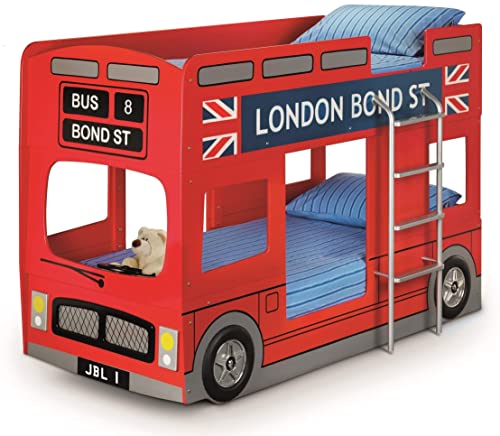Are Kids Ready For Bunk Beds?

Bunk beds are the ideal solution for small children’s rooms. They can be used as a study or playroom during the daytime.
You will need to evaluate your child’s dexterity and maturity when they are ready to move into a bunk bed. You will also have to consider their sleeping habits.
Age of Transition from the Top Bunk
The age at when children are ready for bunkbeds can vary greatly. However, the majority of experts recommend that children don’t sleep on the top bunk until they’re at least six years old. Children under 6 years of age aren’t likely to have the dexterity and maturity to safely navigate the ladder. They may also have difficulty understanding and following safety regulations like not jumping off the top of the bed or climbing on the guardrails.
It’s also important to consider how rambunctious your child is in determining if they’re ready for a bunk bed. Children who are disruptive or do not follow the rules shouldn’t use bunk beds because they could cause serious accidents. Children who are more likely to fall out of the bed or who are taller than average might not be able to use the top bunk safely even if they’re 6 years old. older.
As kids grow older, they could outgrow their bunk beds. In this case it’s an ideal idea to move to a traditional bed to allow them to enjoy more spacious and comfortable sleep. It could be as easy as switching to twin beds, or as complex as investing in a unique treehouse bunk bed like the Mathy by Bols bunk bed that transforms into a full-size bed.
It’s best to begin by starting with the bottom bunk and then work your way up. By doing this, you will ensure that your child is both mentally and physically ready for the transition. This will ensure that they don’t get discouraged if the chance to move to the top bunk isn’t offered to them immediately.
It’s also recommended to educate youngsters the importance of observing safety rules, no matter the position they are sleeping on the bed. This includes teaching youngsters not to fall off the bunk, to not hang objects from the rails, and to use the ladder properly.
Safety Considerations
Bunk beds can be a great sleeping option for children however, it’s crucial to keep in mind the dangers to safety. By understanding the risks, following the instructions for assembly provided by the manufacturer and implementing other safety measures, you can ensure your children have fun in their bunk beds fun without risk.
One of the biggest safety concerns involves the ladder, which could be used to climb up or from the top bunk. If kids aren’t properly watched, they could use the ladder for play and could end up with negative consequences. Incorrectly secured ladders can fall off the side of a bunk bed, creating a trap for children and resultant in fatal head injuries. Children could also slip on the ladder and lose balance while attempting to climb it, which could result in a fall.
To decrease the risk of accidents, make sure you instruct your children to only use the ladder to go up and down, not to play. A night light or some other form of lighting near the ladder is also a good idea. This will help children navigate their steps through the dark, and prevent them from tripping or falling on furniture or toys in the room.
Safety considerations include ensuring that the mattress is positioned on the bunk bed frame properly, ensuring that the bed is placed away from windows, blinds ceiling fans, and cords and ensuring that there aren’t any sharp edges on the ladder or the bunks. It is also crucial to prohibit rough play and horseplay on the bunks, as this can cause structural damage and cause injuries.
Before you let your children get into the bunks take them through an extensive inspection to ensure there aren’t any loose screws or weak points or danger spots. Make sure that there aren’t any gaps between the safety railings, headboards or ladders where a child could get their head or limbs trapped. These gaps should be no greater than 3.5 inches. In accordance with safety guidelines, you must also ensure that the guardrails on either side of the top bunk are 5 inches or more above the mattress.
Choosing the Right Bunk Bed
Bunk beds can bring an enjoyable and social environment to children’s rooms and there are a myriad of different options to pick from. With thoughtful considerations and your children’s input, you can find the ideal bunk bed layout that maximizes space while accommodating a range of sleep preferences and needs.
To help bunk beds for kids navigate the process of choosing a bunk bed begin by looking through the wide range of finishes and materials to find the right bed for your children’s bedroom design. Consider the style of the headboards and feetboards as well the type of slats you prefer or solid panels or curved bed ends. Select a color that complements the interior of your home and can endure the test of time and trends.
Then, consider if you prefer bunk beds with a ladder, angled ladder, or a staircase. Each of these options offers unique safety and convenience benefits. Ladders, angled ladders and staircases are all options to make space but are difficult for younger children to climb.
Standard bunk beds are two twin beds placed perpendicularly on top of another, with a ladder or staircase to get to the top. Alternately, you can look into a loft bed with a space underneath to store things as well as a desk or play space. These beds can also accommodate a full-sized mattress on the bottom and a twin on top, providing flexibility in the dozing options for children sharing bedrooms or vacation homes.
It’s time to shop for the bunk bed that’s ideal for your family. Visit furniture stores, home-improvement centers and online retailers for the perfect bunk bed to meet your children’s needs.
Pay special attention to the frame material you choose when choosing a bunkbed. It is crucial for your children’s safety as well as comfort. Avoid cheap, low-quality materials that could break or sag rapidly. Solid woods are better than particle boards, which are composed of smaller pieces of wood that have been glued together. They are more durable and stable.
Getting Started
There’s a point in the lives of most kids when they absolutely love the idea of bunk beds. They’re the perfect solution to a sibling fight over who sleeps in the top bunk, and it’s a great way to accommodate more than one child in a small space. Bunks are also a fun and practical way to entertain friends for sleepovers without the need of extra bedding.
When you are selecting the ideal bunk bed for your family, there are some important aspects to take into consideration. First, think about whether your children can get in and out of the top bunk in a safe and comfortable manner. This is particularly crucial for kids who are prone to sleepwalking, or have difficulty avoiding rolling over the bed’s side. If they are unable to do it without difficulty, then a ladder might be the best option.
Another crucial aspect to consider is the overall look and style of the bunk bed’s design and style. You’ll want to make sure that it is in line with the style of your bedroom and that your children enjoy it. Bunks are available in many styles, ranging from traditional to modern. They can also be made from various materials, including pine and MDF, according to your preferences and the price range you are comfortable with.
It is a good idea to create a list of all the tools you’ll need before you begin building your bunk beds. This will help avoid any frustrations such as discovering that you’ve misplaced a screw halfway through the build.
You can make your bunk bed more appealing to your kids by being creative. There are many interesting accessories you can choose from. For instance themed bed tents could transform the top bunk into a fort or castle. Your kids will love to play there all day and at night. ).
You will have to encourage your children to put their toys away when they have finished playing. You can keep your child’s room tidy and neat by using a bunk bed with storage built-in.
Business Hours
| Open | Close | ||
|---|---|---|---|
| Monday | Open (24 Hours) | ||
| Tuesday | Open (24 Hours) | ||
| Wednesday | Open (24 Hours) | ||
| Thursday | Open (24 Hours) | ||
| Friday | Open Today (24 Hours) | ||
| Saturday | Open (24 Hours) | ||
| Sunday | Open (24 Hours) | ||


Leave feedback about this